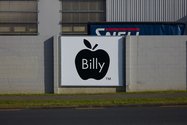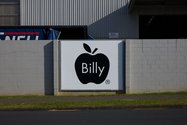John Hurrell – 2 May, 2018
With the ‘TM' and ® status came firstly the distribution rights for Printed Matter (Class 16), Clothing (Class 25), Fresh Fruit (Class 31), and Orchard Services (Class 44). Then came Non-Alcoholic Beverages (Class 32) and Alcoholic Beverages (Class 33). However the Fresh Fruit (Class 31) application for registration resulted in a challenge from the Washington Apple Commission. Apple is currently negotiating with this filed opposition before the dispute goes through an Intellectual Property Office hearings process, as well as seeking to confirm the security of his (Class 44) Orchard Services rights.
Pakuranga
Billy Apple®
Trademark Registration
11 March - 6 May 2018
Let’s break it down to four stages: the creation and transmutation of Billy Apple in his nominal and legal status.
They are:
(1) The life and art practice of Barrie Bates, after he was born in Auckland on 31/12/1935 and before he changed his name in London on 22/11/1962.
(2) The creation of Billy Apple that he confirmed by his change in appearance, his new social behaviour in terms of identity, its activities and representation—a very focussed practice that continued for another forty-five years—and a traveller’s passport. (This was accentuated by his activity of branding himself as an art object, and making of sculpture or lithographs of the fruit as a kind of self portrait.)
(3) The logo Apple designed in the early 2000s, of the apple fruit into which he inserted his name, forming a company (Billy Apple Ltd) in anticipation of a specially developed apple that could be harvested and marketed. (This image was his own logo but it lacked legal back up as intellectual property).
(4) Billy Apple as a brand then changed so that in 2007—with the help of Minter Ellison Rudd Watts—his constructed name and logo legally acquired the status of an unregistered trademark and then a registered trademark, giving him greater legal clout and wider protection.
Looking at (1): Even as a precocious student at the Royal College of Art in London, Barrie Bates was creating ‘Pop’ work that investigated the commercial mechanisms that sustained shops, art galleries and artists. He was fascinated by the processes of advertising and marketing, and their uneasy relationship with the ‘more serious’ art world.
Looking at (2): Through discussions with his friend, the painter Richard Smith from whom he rented a studio flat, the twenty-six year old Bates decided on ‘Billy Apple’, abandoning his birth name. The Apple brand was born.
Looking at (3): The apple fruit logo, a variation of photographs of apples on a tree being signed with a cursive ‘Billy’—or stuck with a transparent oval sticker on which his Christian name was printed—he had developed for several years before the legalities of the trademarking process were finalised, so that the unregistered (and then registered) ‘TM’ could be added.
Looking at (4): Apple‘s interest in his own intellectual copyright seems to have come after he felt some of his ideas were ripped off by Max Factor (see interview with Nicholas James in Billy Apple ®: Apple Brand, CV Publications, 2011) With the ‘TM’ and ® status came firstly the distribution rights for Printed Matter (Class 16), Clothing (Class 25), Fresh Fruit (Class 31), and Orchard Services (Class 44). Then came Non-Alcoholic Beverages (Class 32) and Alcoholic Beverages (Class 33). However the Fresh Fruit (Class 31) application for registration resulted in a challenge from the Washington Apple Commission. Apple is currently negotiating with this filed opposition before the dispute goes through an Intellectual Property Office hearings process, as well as seeking to confirm the security of his (Class 44) Orchard Services rights.
In 2012 Apple® also became involved with a project initiated by biochemist and artist, Dr. Craig Hilton, where he donated blood cell tissue to a Massachusetts research organisation, American Type Culture Collection—and to the laboratory of Auckland Professor Rod Dunbar—where in both cases it will be kept alive, its DNA studied for cancer research, and the possibilities of immortality investigated. Here Apple® continues a process akin to much earlier art works involving bodily substances, but now incorporating possibilities that after his death he will never know the details of—but which hopefully will be of immense interest to future legal scholars, oncology scientists and art historians.
John Hurrell
Recent Comments
Ralph Paine
Getting into the same collections or a mention in the same art history books means jack sh_t! Sure, we might ...
John Hurrell
The same forces? Remember Billy emerged in the early sixties as part of the early Conceptual art movement--he is in ...
Ralph Paine
What I’m suggesting is that the forces and desires propelling Billy Apple’s career trajectory are pretty much the same ones ...



 Two Rooms presents a program of residencies and projects
Two Rooms presents a program of residencies and projects Advertising in this column
Advertising in this column



This Discussion has 5 comments.
Comment
Ralph Paine, 1:24 p.m. 2 May, 2018 #
Is there some divinatory connection between the recently proposed closure of Elam Library and the apotheosis of Billy Apple?
Hmmmm, seems on the cards that some weirded-out combo of a law school, a business school and a science lab will form the coming art school. Why not?
Meanwhile, all magic is destined to happen elsewhere.
John Hurrell, 5:01 p.m. 2 May, 2018 #
This supposed connection, Ralph. Is there some logical underpinning behind it or are you just trying to wind the artist and his supporters up?
Ralph Paine, 11:55 a.m. 4 May, 2018 #
What I’m suggesting is that the forces and desires propelling Billy Apple’s career trajectory are pretty much the same ones propelling the permanent restructuring of Elam. What might we call these forces and desires? State-Capitalist? Neoliberal-State-Capitalist? The Austrian School (“individual human beings act”)? Rogernomics? Business-As-Usual? Doctrine of the Elect? Post-conceptual Corporatism? Take yr pick.
By employing a little divinatory logic (or if one prefers, futurology, scenario running, speculative fiction, etc etc) I’m suggesting further that “some weirded-out combo of a law school, a business school and a science lab will form the coming art school.”
But hey, maybe I’m wrong, maybe a vast sea change is in the offing, maybe renewed & truly monstrous forces and desires are stirring, rising. What might we call these forces and desires? Gaia? Rangi-Papa? Multitudo? Commonism? Supercommunity? Again, take yr pick.
Maybe then the students and staff (and friends) of Elam are gonna rise up, occupy the building, go on strike, build a zone of defence.
John Hurrell, 8:23 p.m. 4 May, 2018 #
The same forces?
Remember Billy emerged in the early sixties as part of the early Conceptual art movement--he is in the same collections and books as say Hans Haacke, Conrad Atkinson, Art & Language or Bruce Barber, all of whom vehemently oppose neoliberal capitalism. Of course Billy often has money as a central preoccupation, and I think his Sold paintings, as astheticised receipts, are amongst his most profound works. Yet I partially agree with you--he does openly admit he has the mindset of a company CEO. His own company.
Either way, to grasp the complexities of his practice, good art historical research in a specialist art history library is essential. The idiots trying to close our specialist libraries are ignorant of how art status in the marketplace or experimental spaces is acquired. Informed commentaries and reviews are essential for writers and gallery staff to do their job to build up or undermine reputations. To evaluate and argue. Traditional university values.
Ralph Paine, 11:19 a.m. 7 May, 2018 #
Getting into the same collections or a mention in the same art history books means jack sh_t!
Sure, we might wanna place Billy in the same (expanded) field as these other artists, but surely not in the same camp.
And I did write “career trajectory” John, like, if once upon a time Billy dabbled in some cool alchemy and ritual, for a long time now it’s been nothing but art-as-asset, golden ratios, finance and private property.
Put another way, Billy’s trajectory goes from a zone of shamanistic transformation, metamorphosis and becoming to a priestly one of exchange, identity and filiation.
Or, taking in the full karmic circle, Billy starts in retail advertising, wanders in the forest for a while, and then ends up back in retail advertising.
Last time I saw an Apple in the flesh was at New World in Freemans Bay—a display promoting bottles of cider.
In any event, while everyone is waxing lyrical about their Elam library experiences (I'm sure Peter Shand et al. are shaking in their jack boots) nobody seems to give a sh_t about Te Tuhi programming in some free retail advertising for Billy's brand (and maybe even giving him an art director's fee????).
Participate
Register to Participate.
Sign in
Sign in to an existing account.